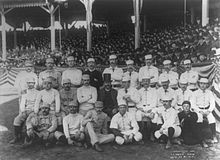- Obscene gesture
-
 Baseball pitcher Old Hoss Radbourn pictured giving the finger to cameraman, 1886. (Back row, far left). First known photograph of gesture.[1]
Baseball pitcher Old Hoss Radbourn pictured giving the finger to cameraman, 1886. (Back row, far left). First known photograph of gesture.[1]
Although "the finger" has been called "the universal sign of disrespect",[2] it is not truly universal. For example, in Japanese Sign Language, when the palm is facing out, it is recognized as the letter Se. Many other gestures are used in addition to, or in lieu of, the finger in various parts of the world to express the same sentiment.
In the UK and Ireland, the V sign (the middle and index finger, when given with back of the hand towards the recipient) serves a similar purpose.
In countries where Spanish, Portuguese, or French are spoken, and especially on the Iberian peninsula and in some parts of Latin America, a gesture called the Bras d'honneur involving raising a fist and slapping the biceps on the same arm as the fist used, sometimes called the Iberian slap or Iberian finger, is equivalent to the finger. Italy, Poland, and countries under the influence of Russian culture (Russia, Belarus, Ukraine) also see the Bras d'honneur as equivalent to the finger. In Guatemala, a gesture equivalent to "the finger" is made by "throwing the hand" forward, digits wide spread, thumb up, pinky down, palm to the left if action is made with right hand (conversely for left hand). This is similar in orientation to the way one would extend for a friendly hand shake, except the arm-wrist-finger assembly is straight, rigid and fully extended in the direction of the target individual.
More commonly in Russian-influenced areas, the fig sign (also known as shish) serves as the equivalent to the finger. The gesture is typically made with the hand and fingers curled and the thumb thrust between the middle and index fingers. This gesture is also used similarly in Indonesia, Turkey, China, and Mongolia.
In some African and Caribbean countries, a similarly obscene gesture is extending all five digits with the palm facing forward, meaning "you have five fathers" (thus calling someone a bastard).[3]
According to Gestures: The Do's and Taboos of Body Language Around the World, by Roger E. Axtell, in former Persia, mainly Iran and Iraq, a gesture involving exposing only the thumb in a vertical orientation—a thumbs up—is used in lieu of the finger to express roughly the same sentiment.
In some Arab countries, especially Egypt, the middle finger is lowered towards the palm and pointed towards someone, while all other fingers are kept straight. It could be considered the opposite movement of the tradition middle finger gesture, but it serves the same purpose and meaning.
In Greece, the five fingers are spread wide and the palm is pushed towards someone in a gesture known as the Moutza. The middle finger is still used though, and it is considered more insulting. Another variation of the middle finger is used, where all the fingers but the middle one are spread wide while moving the hand back and forth in the axis the middle finger creates. In this gesture, the thumb sometimes touches the middle finger. The insult of this move may vary, being sometimes equivalent to the Moutza (still it is less insulting than the usual and universal middle finger). This gesture means that somebody is in a bad situation, either the one who is doing the gesture or the one receiving it.[citation needed]
In India, Pakistan, and Sri Lanka the social circles exposed to the western cultures use the middle finger gesture in the same sense that it is used in those cultures. The same is true for most South Asian countries.
In William Shakespeare's play Romeo and Juliet, Capulet's servant Sampson starts a fight by "biting his thumb" at Abraham, Montague's servant. This gesture can be interpreted as being equivalent to giving someone the middle finger.
References
- ^ *Achorn, Edward. Fifty-nine in '84: Old Hoss Radbourn, Barehanded Baseball, and the Greatest Season a Pitcher Ever Had. 2010, Smithsonian Books, ISBN 978-0061825866, p. 24
- ^ E.g., Echard v. Kraft, 159 Md. App. 110, 115; 858 A.2d 1018, 1021 (2004).
- ^ "What's A-O.K. in the U.S.A. Is Lewd and Worthless Beyond". The New York Times. 1996-08-18. http://query.nytimes.com/gst/fullpage.html?res=9D0DEED61039F93BA2575BC0A960958260&sec=&spon=&pagewanted=all. Retrieved 2008-04-11.
Gestures Friendly gestures Air kiss · A-ok · Cheek kissing · Dap greeting · Elbow bump · Eskimo kissing · Fist bump · Hat tip · High five · Hongi · ILY sign · Namaste · Sign of the horns · Shaka · Thumbs signal · WaiFormal gestures Salutes Bellamy salute · Nazi salute · Raised fist · Roman salute · Scout sign and salute · Three-finger salute · Two-finger salute · Vulcan salute · Zogist saluteCelebratory gestures Finger counting Obscene gestures Head motions Other gestures Air quotes · Anasyrma · Crossed fingers · Facepalm · Finger gun · Gang signal · Hand-rubbing · Jazz hands · Kuji-in · Laban sign · Loser · Mudra · Pollice verso · Puppy face · Shrug · Sign of the Cross · Varadamudra · V signRelated Categories:- Gestures
Wikimedia Foundation. 2010.
